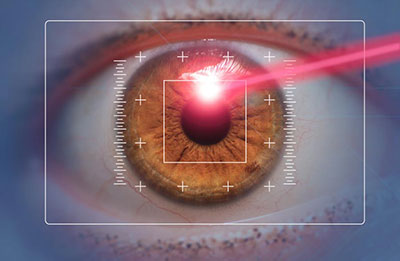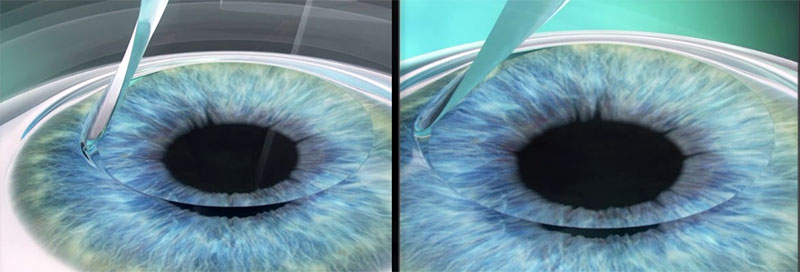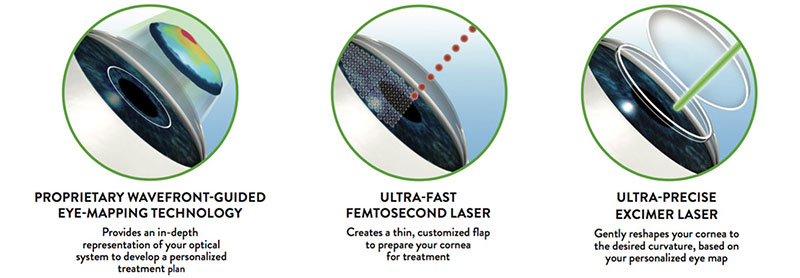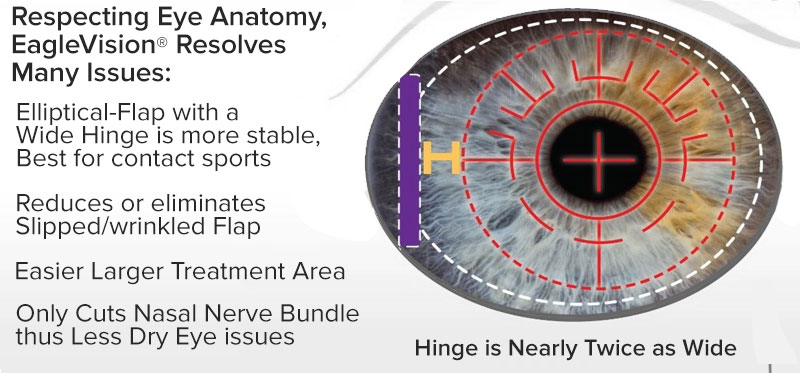- Home
- Resource Library
- LASIK and Vision Correction Resources
- The Evolution of LASIK Surgery
The Evolution of LASIK Surgery

Is there more than one kind of LASIK laser eye surgery?
Yes, since the invention of EagleVistion LASIK at the Assil Gaur Eye Institute, there are now FIVE evolutions in LASIK technology.
There’s a whole spectrum of LASIK technology being marketed today, ranging from what many consider obsolete technology to leading-edge EagleVision LASIK: the choice of those whose vision is their lifeblood, such as LeBron James.
- How does LASIK work?
- 1st Generation (1G) LASIK: basic LASIK with Keratome Blade
- 2nd Generation (2G) LASIK: standard Bladeless LASIK
- 3rd Generation (3G) LASIK: ContouraVision™ and SMILE LASIK
- 4th Generation (4G) LASIK: iDesign™ LASIK
- 5th Generation (5G) LASIK: EagleVision®️
- Want to schedule a consultation with our world-class LASIK specialists?
How does LASIK work?
Before discussing what’s unique about each of the five generations of LASIK technology, let’s first review how LASIK surgery corrects your vision.
Two main factors largely determine your vision prescription:
- The length of your eyeball from front to back.
- The shape of your cornea (the transparent surface or “windshield” through which light is filtered and focused onto your retina).
Because two-thirds of your eye’s ability to focus light resides in the cornea, vision correction research has centered on improving the cornea’s ability to refract (focus) light.
Thus, your vision prescription is known as your “refractive error” – in other words, the amount by which your cornea’s focusing ability deviates from normal 20/20 vision.
LASIK was developed to correct refractive errors. Simply put, a laser beam painlessly carves a part of your corneal surface to create a little flap. The flap is then opened like a book cover so that the laser’s ultraviolet rays can reshape the underlying cornea to make it focus light accurately onto the retina. The flap is then folded back into place, and your eye heals very quickly on its own.
Now that we’ve explained the LASIK fundamentals. let’s examine the five generations of LASIK technologies available today.
1st Generation (1G) LASIK: basic LASIK with Keratome Blade
The technique: In “old-fashioned” basic LASIK, the surgeon uses a blade known as a microkeratome to manually cut a thin hinged corneal flap, and then a simple unguided excimer laser performs the corneal sculpting.

Pros of Basic LASIK
- None other than price. It is a less expensive procedure since only a single laser is used.
Cons of Basic LASIK
- There are many downsides to this dated technique, which is 30 years old. All of them involve inferior vision outcomes compared to modern techniques.
- This technology can only be found at “bargain” LASIK eye centers.
2nd Generation (2G) LASIK: standard Bladeless LASIK
The technique: This bladeless LASIK approach is similar to traditional LASIK, but instead of cutting a flap by hand, the surgeon creates the flap using an infrared laser (called a femtosecond) to create a microscopically thin flap.
The underlying cornea is then sculpted with an excimer laser, which divides the eye’s seeing surface into 200 zones and individually sculpts each one.

Pros of Standard Bladeless LASIK:
- Cost Savings is the only real upside of this type of LASIK
- The ability to create a thinner corneal flap than the prior generation facilitates quicker recovery
Cons of Standard Bladeless LASIK:
- Because only two laser technologies are used, this forces the patient into a “one size fits most” methodology
- There is no real surgical planning available for customization for the individual patient
- This is another very basic LASIK procedure usually only found at “bargain” LASIK eye centers
3rd Generation (3G) LASIK: ContouraVision™ and SMILE LASIK
Contoura Vision™ technique
FDA approved in 2016, Contoura Vision™ as a more advanced LASIK technique that uses a device called a “Wavelight Topolyzer VARIO” to provide more customized vision correction using “corneal topography.”
This divides the eye into 22,000 different zones, measures the surface contour for each one, and then sculpts them all to an average of all the zones. This technology was the first to make LASIK possible for patients with nearsightedness, farsightedness, and/or astigmatism.

Pros of ContouraVision™ topography-guided LASIK
- This technique is much better for patients with a highly abnormal corneal shape than the prior two generations.
- Contoura had fewer post-op complaints of light sensitivity, night driving problems, reading difficulty, glare, halos, and starbursts than previous LASIK generations.
Cons of ContouraVision™ topography-guided LASIK
- Corneal topography is just one of several factors responsible for your eye’s focusing power and does not address the others.
- Contoura does not correct the precise refractive error at each treatment zone but computes an average refractive error used to correct the entire corneal treatment area. That means this technology can generally equal the correction power of eyeglasses but falls far short of the visual correction of the most modern LASIK technologies (4G and 5G).
SMILE LASIK technique
SMILE LASIK (which stands for “Small Incision Lenticule Extraction”) was introduced in 2011 and is a completely different surgical approach than any other LASIK procedure.
A Femtosecond laser creates a tiny curved incision along the side of the cornea and then works just below the cornea’s surface, carving out a small disc of tissue (called a lenticule) that is eliminated. As a result, the shape of the cornea is modified, and the patient’s nearsightedness (and ONLY nearsightedness) is corrected.

Pros of SMILE LASIK
- Like Basic LASIK, SMILE only uses a single laser and a simple surgical plan, so the treatment is much more economical than more refined surgical approaches combining more advanced technologies.
Cons of SMILE LASIK
- Although advertised as an advanced vision correction technique, SMILE is popular, whereas today’s most modern LASIK is not readily available, such as in China.
- Because a single laser (Femtosecond) performs both the corneal incision and the corneal sculpting, the reshaping is “somewhat crude” compared to the Excimer laser used in modern LASIK surgery, which works at the molecular level.
- SMILE is limited to ONLY correcting simple forms of nearsightedness. It’s not suited for correcting farsightedness, significant astigmatism, high nearsightedness, or other vision deficits (known as higher-order aberrations). These can only be corrected using more advanced LASIK technology.
- In clinical trials, fewer patients achieved 20/20 vision following SMILE surgery than the LASIK technology available.
- If further subtle vision corrections (called enhancements) are needed after a SMILE procedure, a second SMILE procedure cannot perform advanced fine-tuning. You must undergo a totally different type of LASIK procedure to obtain additional vision correction beyond what SMILE can achieve.
Schedule your FREE LASIK consultation with those Lebron James trusts with his eyes
4th Generation (4G) LASIK: iDesign™ LASIK
The technique: iDesign™ takes LASIK technology significantly beyond Contoura using Wavefront technology. This creates a custom 3-D map of your entire visual pathway (namely, how a light beam travels from the front of the eye, through the cornea, and all the way to the retina). Furthermore, Wavefront divides the “seeing” surface area of the eye into over 1,200 adjacent zones and measures each zone’s prescription individually.
By combining Wavefront data and topography data (the rises and dips in the cornea’s surface), iDesign creates an extraordinarily personalized surgical program. This program guides the laser to correct the refractive error of each individual zone (as opposed to other laser systems, which correct the entire visual surface for just one prescription measurement).
These detailed measurements create a significantly better surgical outcome than was achievable with any prior generation of LASIK.

Pros of iDesign Wavefront and Topography guided LASIK
- Wavefront technology can measure and treat eyesight deviations beyond simple nearsightedness, farsightedness, and astigmatism
- Wavefront also measures and corrects higher-order aberrations (HOA): complex vision imperfections that can cause glare, halos, starbursts, and contrast sensitivity. The level of detail offered by Wavefront-guided LASIK is akin to that of an artist using a fine paintbrush versus an airbrush
- In large studies, iDesign patients’ average post-LASIK vision correction exceeded their best pre-LASIK vision correction while wearing their glasses or contacts
- iDesign also outperformed Contoura™ for post-op visual acuity and contrast sensitivity.1
- iDesign had less post-op nighttime glare than Standard LASIK.
Cons of iDesign Wavefront and Topography guided LASIK.
- The only downside is cost: this approach is more expensive because it requires the integration of three sophisticated technologies (Excimer Laser, Femtosecond laser, and iDesign) to create a customized treatment plan.

5th Generation (5G) LASIK: EagleVision®️
The technique: The very latest LASIK protocol, EagleVision®️ (which stands for Elliptical-flap Aberrometry Guided Laser Enhanced Vision), was developed by renowned LASIK expert Dr. Kerry Assil.
EAGLE combines the best surgical techniques and technology to achieve outstanding visual correction. That’s why EagleVisionTM was the choice of LeBron James, Chris Paul, Paul George, Dwyane Wade, and thousands of other satisfied patients.
EagleVision® ️LASIK uses Wavefront technology, subdividing the eye’s “seeing” surface area into 1240 adjacent zones and measures each one’s focusing capacity and optical imperfections that glasses cannot correct.
EagleVision® LASIK takes LASIK to the next level by further customizing two critical components of LASIK surgery: the laser navigation guidance program and the corneal flap design.
- Laser navigation guidance customization: The EagleVision®️ protocol uses proprietary algorithms developed by Dr. Assil to further customize the laser’s surgical treatment program to account for patient age, lifestyle, and eye shape. This allows us to give each and every eye the most personalized treatment available anywhere.
- Corneal flap customization: EagleVision®️ also utilizes a unique surgical approach developed by Dr. Assil featuring an elliptically shaped laser treatment zone that not only provides safe access to a larger corneal treatment area but also creates a sturdier flap, making EagleVision the choice for those who work or play in high impact sports or endeavors.
- Proprietary customized surgical navigation: AGEI surgeons use a proprietary customized surgical navigation program developed by Dr. Assil to guide the VISX S4 excimer laser to sculpt the seeing surface of the cornea according to exact specifications that are unique for each eye. The result is sharper vision than ever before, with fewer post-op dry eye symptoms that are seen with other LASIK approaches.

Pros of EagleVision®️ LASIK Laser Eye Surgery
EagleVision®️ advantages over other LASIK technologies include:
- EagleVision™ LASIK achieves sharper post-op visual acuity
- The ergonomic flap design offers a larger treatment area and greater flap stability, which provides added protection against eye injury and quicker healing.
- EagleVision™ has a lower incidence of post-op Dry Eye findings.
Cons of EagleVision®️ LASIK Laser Eye Surgery
- As with iDesign LASIK, EagleVision®️ LASIK requires the integration of three highly refined technologies (Excimer Laser, Femtosecond laser, and iDesign). The surgeon further customizes the surgical plan using a custom algorithm tailored to each patient, which comes at an increased cost.
- Eagle Vision is currently only available at AGEI because it requires a very experienced surgeon and surgical team due to the high level of customization and technology involved. Dr. Assil has personally trained the surgeons at Assil Gaur Eye Institute and has the skill and experience to deliver the best visual outcomes available today.
Want to schedule a consultation with our world-class LASIK specialists?
It’s easy. Simply click here to request an appointment online or call 866-945-2745. During your consultation, our doctors will perform a dilated eye exam, measure the shape and thickness of your cornea, pupil size, and refractive errors, and review your vision goals and overall health to ensure that EagleVision®️ or iDesign™ LASIK is truly right for you.
We are conveniently located for patients throughout Southern California and the Los Angeles area in or near Beverly Hills, Santa Monica, West Los Angeles, West Hollywood, Culver City, Hollywood, Venice, Marina del Rey, Malibu, Manhattan Beach, and Downtown Los Angeles.
References:
J Refract Surg. 2015 Jun;31(6):398-405. doi: 10.3928/1081597X-20150521-06
Assil, K. K., & McCall, T. (2005). Temporal hinge laser in situ keratomileusis: maximizing treatable stromal bed area. Journal of cataract and refractive surgery, 31(6):1139-1144.














